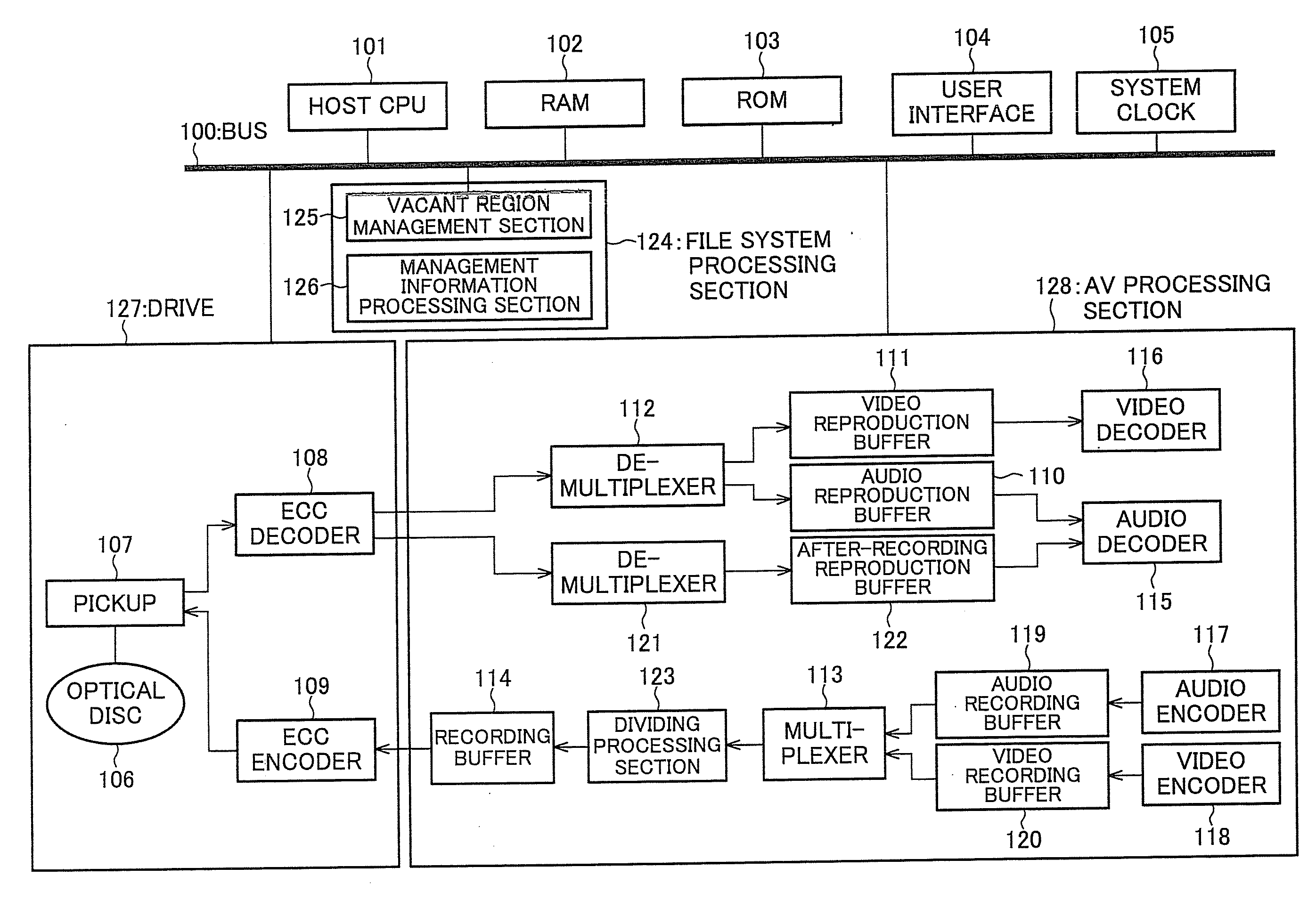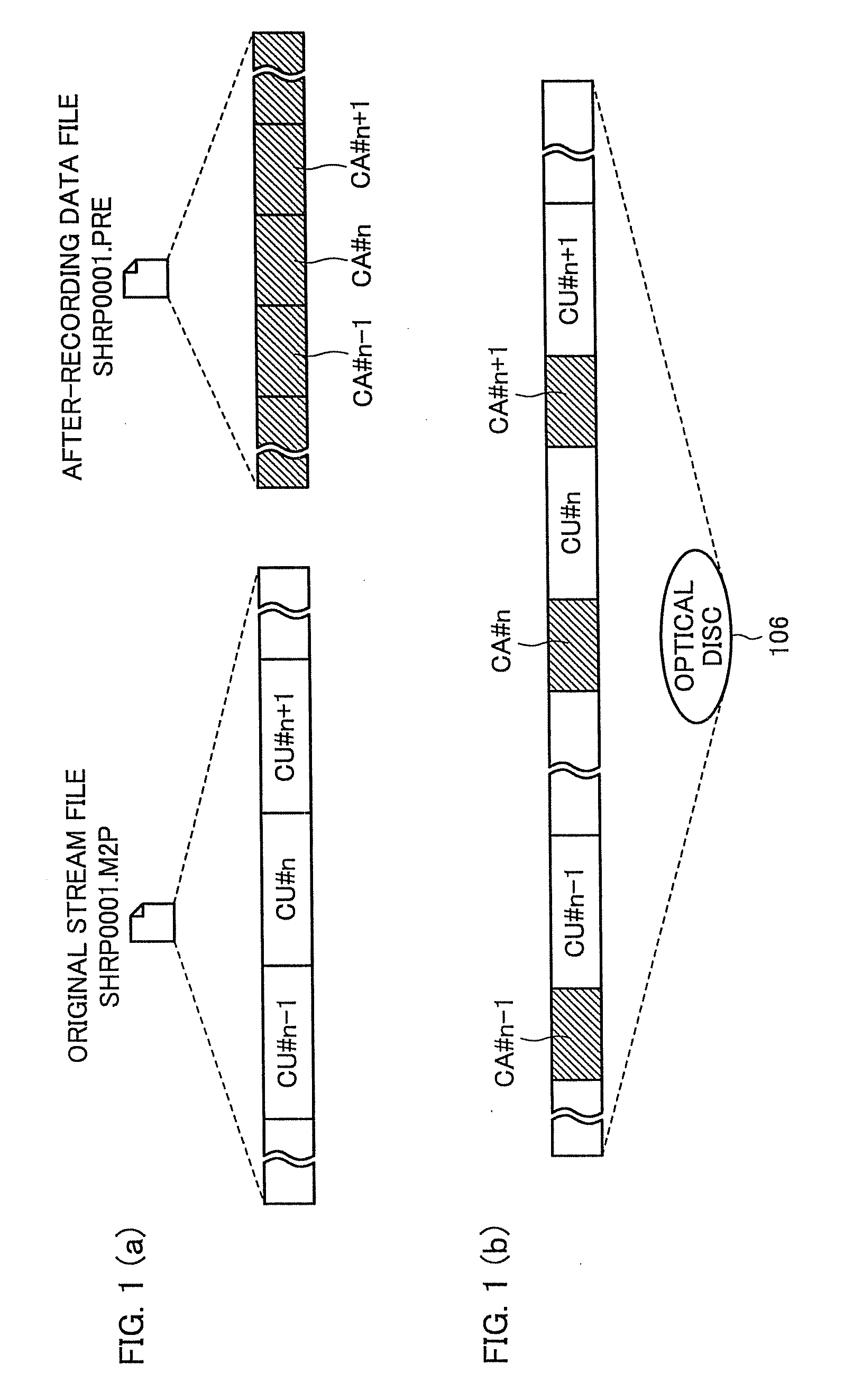Method for recording av data and associated data, av data recording apparatus, av data reproducing apparatus and method, and recording medium
a technology of which is applied in the field of recording av data and associated data, av data recording apparatus, av data reproducing apparatus and method, and recording medium, etc., can solve the problem that the after-recording function suffers from a difficulty in real-time after-recording, and the general decoder cannot normally carry out decoding for reproduction
- Summary
- Abstract
- Description
- Claims
- Application Information
AI Technical Summary
Benefits of technology
Problems solved by technology
Method used
Image
Examples
embodiment 1
[0076]Embodiment 1 of the present invention will be explained below with reference to FIG. 1, and FIG. 4 through FIG. 18.
[0077]
[0078]A file / directory structure according to Embodiment 1 is explained with reference to FIG. 4. As shown in FIG. 4, data of Embodiment 1 is stored in five types of files.
[0079]An original stream file (SHRP0001.M2P) is a file prepared per picture recording, and is in compliance with the MPEG-2 PS (Program Stream) format. An after-recording data file (SHRP0001.PRE) is a file for (i) securing a region for after-recording, and (ii) storing after-recorded data. An original stream management information file (SHRP0001.OMI) is a file for storing (i) time-address correspondence information about the original stream file; (ii) attribution information about the original stream file; (iii) attribution information about the after-recording data file; and (iv) information indicative of a correspondence correlation with the original stream file. The original stream mana...
modified example of embodiment 1
[0171]In Embodiment 1, data is recorded onto the after-recording data file, in accordance with the MPEG-2 format, as is the case with the original stream file; however, data may be recorded onto the after-recording data file, in compliance with the Elementary Stream in which recording does not utilize such packing and packeting. This cuts out the need of the re-packing after extracting an AAU from a pack and replacing the extracted AAU, when overwriting a part of the after-recorded data of the CA.
[0172]Further, in Embodiment 1, the CA stores the audio data, but may store different types of data such as graphics data to be superimposed on the video in the original stream.
[0173]In Embodiment 1, one AAU can be recorded over a plurality of packs, but may be stored in one pack. With this, a part of the after-recorded data in the CA can be rewritten merely by overwriting a pack containing a relevant AAU.
[0174]In Embodiment 1, when occurrence of the defect in the CA is detected during the ...
embodiment 2
[0177]Embodiment 2 of the present invention will be explained with reference to FIG. 19.
[0178]Differences between Embodiment 1 and Embodiment 2 are as follows. That is, in Embodiment 1, a plurality of sets of data to be synchronously reproduced are continuously disposed in the recording medium, and these sets of data are managed as different files. In contrast, in Embodiment 2, the data sets are in the same reproduction time-line, but are not simultaneously reproduced. In Embodiment 2, reproduction is carried out by switching the data sets between each other.
[0179]Specifically, Embodiment 2 utilizes the multi-angle function in the DVD-Video, i.e., a function for switching images viewed from a plurality of angles in the same time-line.
[0180]Note that a recording operation according to Embodiment 2 is substantially the same as that of Embodiment 1, i.e., the relation between the original stream and the after-recorded data that should be synchronously reproduced in Embodiment 1 is mere...
PUM
| Property | Measurement | Unit |
|---|---|---|
| time | aaaaa | aaaaa |
| frequency | aaaaa | aaaaa |
| AV | aaaaa | aaaaa |
Abstract
Description
Claims
Application Information
 Login to View More
Login to View More - R&D
- Intellectual Property
- Life Sciences
- Materials
- Tech Scout
- Unparalleled Data Quality
- Higher Quality Content
- 60% Fewer Hallucinations
Browse by: Latest US Patents, China's latest patents, Technical Efficacy Thesaurus, Application Domain, Technology Topic, Popular Technical Reports.
© 2025 PatSnap. All rights reserved.Legal|Privacy policy|Modern Slavery Act Transparency Statement|Sitemap|About US| Contact US: help@patsnap.com



